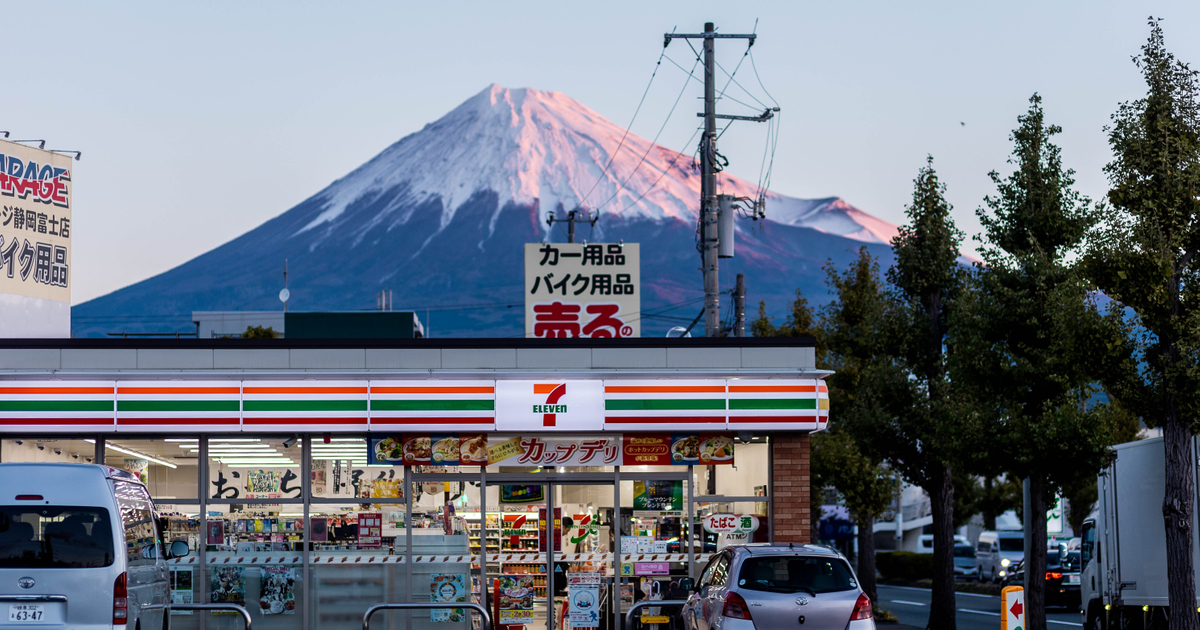Airbot’s new self-cleaning robot vacuum boasts 3 promising features, we test each one out
We review the Airbot Robotic Vacuum Mop L108S Pro Ultra to test its features, here's how the affordable device performed.
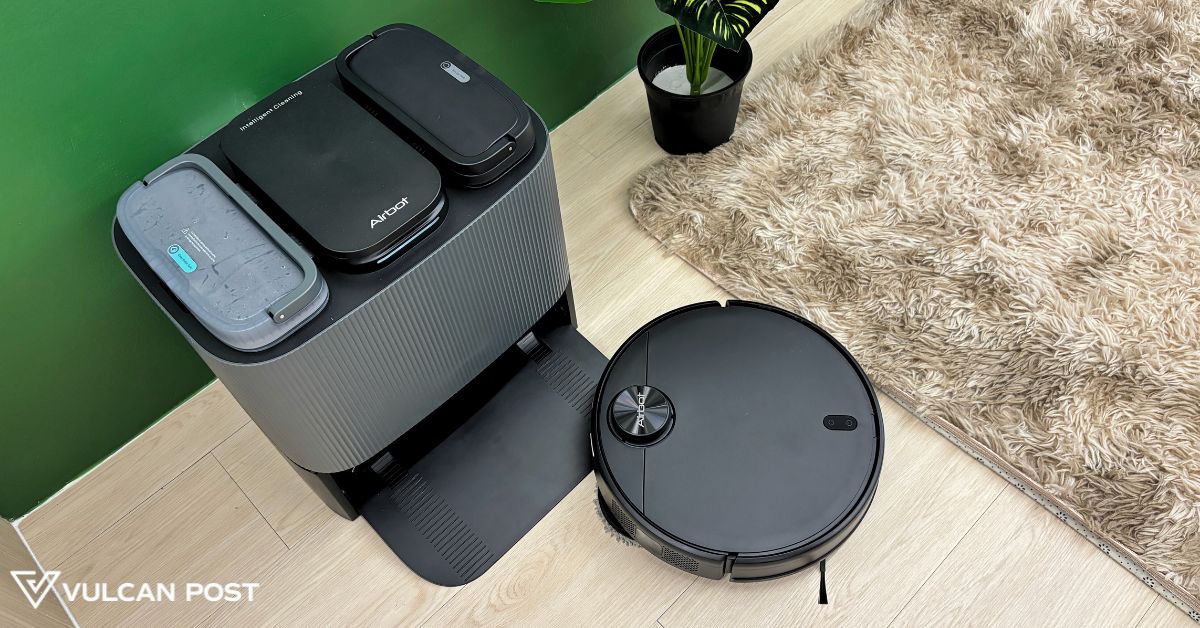
[This is a sponsored article with Airbot.]
I’ve been a big fan of robot vacuum cleaners for their ability to maintain the upkeep of my home by cleaning up dust, dander, and fur without me having to lift a finger.
However, my glee is often dampened by the tedious task of maintaining the unit itself, as my past experience can attest.
As someone with dust allergies, it may be worth investing in a self-sufficient robot with auto bin-emptying capabilities.
So when Airbot came to us to review its newly launched self-cleaning Robotic Vacuum L108S Pro Ultra, I decided to put it to the test based on its promising features.
For context, Airbot is a Singapore-founded brand specialising in air dynamic engineering technology to create high-quality and affordable home appliances for consumers.
Airbot’s product line comprises vacuum cleaners, air fryers, and air purifiers, to name a few, and they’re distributed around China, Japan, Hong Kong, Singapore, Malaysia, and Thailand.
Setting up my little helper
The robot vacuum cleaner is relatively easy to set up. It comes with an extensive set of attachments and accessories to plug and play once you connect it to the Airbot app.
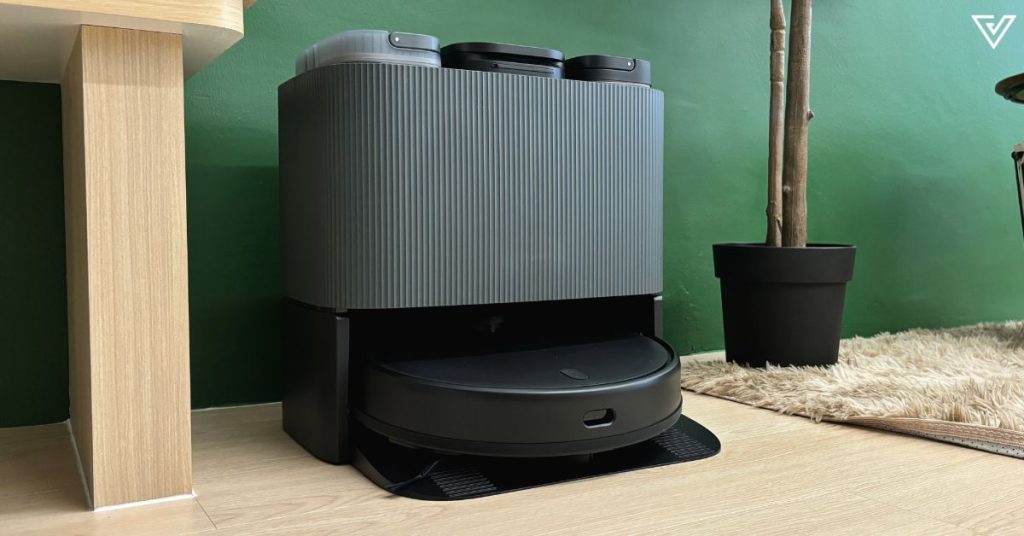 The charging dock comes with a sleek matte black ribbed design / Image Credit: Vulcan Post
The charging dock comes with a sleek matte black ribbed design / Image Credit: Vulcan PostThe box included the vacuum’s charging dock which contains the clean and dirty water tanks and dust collection bag, the robot vacuum with its attached brushes, power cable, and user manuals.
It also contained replacement units for its E11 HEPA filter, dust collection bag, hex side brush, and a tiny cleaning brush.
Testing its promising features
Feature #1: It can smartly map rooms and suggest No-Go Zones
Boasting advanced LiDAR mapping, the Airbot L108S Pro Ultra claims that it can automatically recognise rooms, detect easy-to-get-stuck areas, and propose No-Go-Zones. This will then display invisible walls to block certain areas, which can be further tweaked in the app.
Airbot also states that the robotic vacuum detects and avoids obstacles with ease, with a cliff sensor that prevents it from falling down stairs, for example.
Reality:
With the battery fully charged, which gives the robot up to three hours and 40 minutes of battery life, I let the robot explore my space.
I was impressed by how the robot’s advanced LiDAR mapping could predict the area’s layout even before it completed its first cleanup round.
It’s capable of mapping the space based on the existing walls it senses / Image Credit: Airbot / Vulcan PostIn terms of its obstacle avoidance, I suppose it somewhat lived up to its claims?
During its first few cleanups, the robot’s collision bumper on the front would bump into partition walls and furniture, and rev up its motor while trying to mount onto carpets. This is rather normal for robot vacuum cleaners in my experience, especially in their mapping stage.
After three complete cleanups, the map was saved, and the Airbot L108S Pro Ultra navigated with fewer bumps.
That said, if a chair sits slightly out of its previously mapped spot, the robot would still bump around its legs to clean under the area—kudos for a thorough cleaning job.
Look at it get between all the crevices / Image Credit: Airbot / Vulcan PostInterestingly, throughout my week of testing, I did not notice the robot suggesting any No-Go Zones in the app. Perhaps it didn’t detect any easy-to-get-stuck places in its surroundings.
However, I did manually set up No-Go Zones for areas like the washroom and carpeted areas, which was simple enough to do, and resulted in smoother subsequent scheduled cleanings.
I set up No-Go Zones (the rectangular dotted lines) to avoid carpets and certain rooms / Image Credit: Airbot / Vulcan PostFeature #2: It can deep clean floors
The Airbot L108S Pro Ultra features an 8,000 Pa suction power when vacuuming, which is stronger than typical robotic vacuum cleaners in the market (average of 2,500 to 3,000 Pa). Essentially, the higher the Pa value, the greater the force of lifting debris off the floor.
Mopping-wise, the robot is marketed to have a 400ml high-capacity ionised Ag+ water tank and hot water activation feature. Simply put, this function is meant to heat up water and get the Ag+ ions activated to kill germs and bacteria on the floor.
Reality:
When put through a regular cleanup, the robot performs as expected picking up dust, dirt, and hair around the space.
It vacuums and mops in an S-shaped pattern, giving the floor a thorough clean / Image Credit: Airbot / Vulcan PostIts suction power would also auto-adjust between Eco and Standard modes based on the dust levels it detects, and switches to Strong or Max mode if it’s cleaning a short or long-haired carpet.
Other than dust and hair, it also sucked up larger particles like cookie crumbs relatively well. The robot would use its hex-side brush attachment to push crusty debris towards the vacuum’s main brush to be suctioned into the dust compartment.
Notice how the floor is left with a clean streak as the robot mops its path (right) / Image Credit: Airbot / Vulcan PostWith 200rpm dual spinning mops, it cleaned up my coffee spills with no issue either. The robot’s mops are capable of pressing down with up to 500g pressure, mimicking a human’s manual deep cleaning.
Bye bye coffee spills / Image Credit: Airbot / Vulcan PostWhat I liked about the Airbot L108S Pro Ultra is that the mop function contains some notable features at its base station.
For one, I could adjust the mop’s wash interval times between eight to twelve square metres to ensure that the mop stays fresh and clean throughout its cycles. This prevents the mop pads from spreading around sticky spills throughout the entire space.
This leads me to my favourite aspect of the Airbot L108S Pro Ultra.
Feature #3: It’s self-cleaning and self-emptying
The robot’s charging dock can self-empty the vacuum, meaning it can considerably reduce one’s contact with dust, which is particularly beneficial for those plagued with allergies.
Inside, you’ll get a 2.8L clean water tank, a 2.4L sewage tank (as Airbot calls it), and a 2.7L dust bag that can clean out the robot’s dust cup. Airbot claims that you won’t have to change the dustbag for up to seven weeks’ worth of vacuuming.
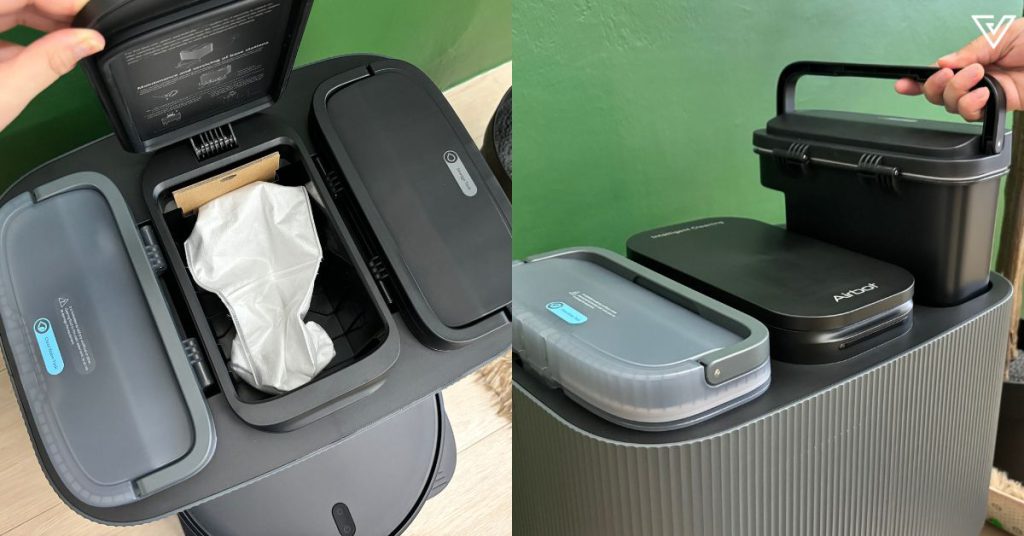 The clearly labelled compartments for dust collection and water tanks for clean and dirty water / Image Credit: Vulcan Post
The clearly labelled compartments for dust collection and water tanks for clean and dirty water / Image Credit: Vulcan PostAdditionally, the charging base has a warm air drying feature to dry the mop pads and prevent mould and bacterial growth.
Reality:
The Airbot L108S Pro Ultra lived up to its claims.
The clean water tank could supply enough water to the robot for a week of scheduled daily cleaning, and the sewage tank thoroughly cleaned the robot’s mop pads as advertised.
Getting its insides cleaned / Image Credit: Airbot / Vulcan PostEven the coffee spill the robot mopped up didn’t leave any stains on its microfibre mop pads. The warm air drying feature could dry the mop pads in three hours, which meant that I didn’t have to separately remove and air dry them after each cleaning session.
And alas, my most appreciated feature of the Airbot L108S Pro Ultra is its effective and efficient dust-collection abilities. On the app, I scheduled to have the base empty the robot’s dust tank after every third vacuum cycle.
This meant that I wouldn’t have to confront the large clumps of dust that would gather in a normal vacuum’s dust tank, which may or may not disperse into the air, and trigger my allergies.
-//-
After all that cleanup, emptying the tanks from the Airbot L108S Pro Ultra’s base was a breeze.
The dust bag had already consolidated all the gunk from the vacuum, and once it filled up, it just needed to be replaced with a new one.
Meanwhile, the sewage water could be easily dumped into the drain and rinsed briefly before the next cleaning cycle.
Ultimately, there’s no way of completely avoiding the loose hairs and dust that get trapped onto the detachable brushes of the robot. The tiny cleaning brush provided in the box came in handy here.
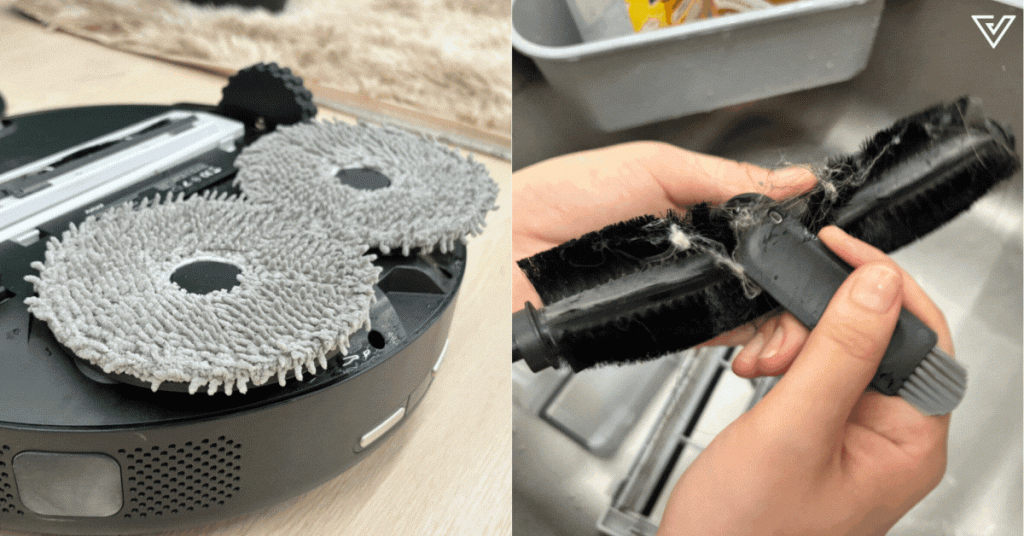 Look at the stain-free mop pads / Image Credit: Airbot / Vulcan Post
Look at the stain-free mop pads / Image Credit: Airbot / Vulcan PostThe Airbot app was intuitive to use as well, giving me remote access to the robot’s functions. I could set up the robot’s scheduled cleaning times, edit its virtual map, and monitor where it’s cleaning in my space.
I could also direct the robot’s path with the app’s remote control, adjust the base’s self-cleaning frequency, view its charging status, and be notified when it’s time to change its consumables (HEPA filter, brushes, dust bag, etc.).
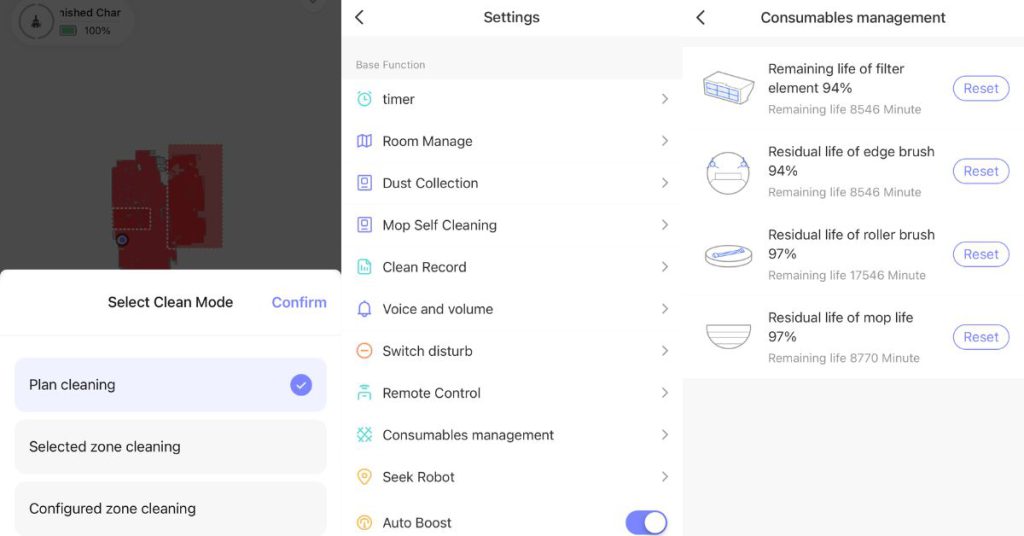 Some settings you can tweak in the app / Image Credit: Vulcan Post
Some settings you can tweak in the app / Image Credit: Vulcan PostAll in all, the Airbot L108S Pro Ultra would be a great helper to have in any household or office to maintain overall cleanliness.
Of course, it’s important to ensure that all cables and small objects are removed from the floor so the robot won’t get stuck in the process like ours did a couple of times.
Priced at RM2,399 (from its original RM5,199), the Airbot L108S Pro Ultra is available for sale on Airbot Malaysia’s official website and its authorised Lazada and Shopee stores.
The device’s one-year warranty (serviceable at Airbot’s service centre in Klang) will be automatically activated when the product is shipped out from its local hub.
Learn more about the Airbot Robotic Vacuum L108S Pro Ultra here. Read more of our reviews here.Featured Image Credit: Vulcan Post

 BigThink
BigThink 




























